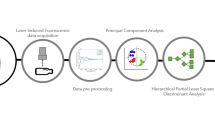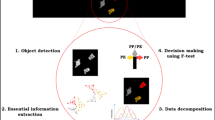Abstract
The aim of this work was to increase the amount of recycled waste wood in the wood-processing industry. Contaminations such as plastics and wood preservatives therefore have to be identified and removed. A promising technique to detect this foreign matter is near-infrared (NIR) spectroscopy. For several organic and inorganic active compounds for wood preservation, the NIR reflectance spectra acquired with sensors with the capability of on-line measurements were characterized. Some of them were significantly different from those of previously published spectra. Moreover, untreated wood was distinguishable from wood treated with preservatives. Confounding factors, such as the water content, wood species and solvent of the preservative, were examined which had so far massively interfered the NIR detection and classification. Chemometric-based solutions are presented in this work to cope with analytical challenges arisen from the complexity of waste wood samples. This formed the basis for a sorting trial in which treated wood chips were detected in real time with an NIR spectrometer and automatically separated by pneumatic nozzles, showing that the laboratory experiments can be transferred into small industrial scale. Additionally, the experiments showed that wood–plastic composites (WPC) of different plastic types were distinguishable with NIR spectroscopy and can be sorted by ejection based on this information. Unmixed material is a major prerequisite for a high-quality recycling of WPC and has never been demonstrated on a technical scale. Furthermore, three different NIR devices (hyperspectral imaging camera, miniaturized spectrometer and sorting plant) were evaluated regarding their applicability in the waste wood recycling process.













Similar content being viewed by others
References
Asbach M, Mauruschat D, Plinke B (2013) Understanding multi-spectral images of wood particles with matrix factorization. Optical Characterization of Materials (OCM) Karlsruhe Institute for Technology, p 191–201. doi:10.5445/KSP/1000032143
Axrup L, Markides K, Nilsson T (2000) Using miniature diode array NIR spectrometers for analysing wood chips and bark samples in motion. J Chemom 14:561–572
Bouslamti MA, Irle MA, Belloncle C, Salvador V, Hulot S, Caron B, Qannari EM (2013) Classification of treated wood using Fourier transform near infrared spectroscopy and multivariate data analysis. Int Wood Prod J 4:116–121
Briesemeister R (2013) Analyzing the suitability of X-ray fluorescence (XRF) devices for detecting foreign material in recovered wood. Diploma thesis, Clausthal University of Technology
Czarniḱ-Matusewicz B, Zeegers-Huyskens T (2000) Mid- and near-infrared study of the hydrogen-bonded complexes between pentachlorophenol and proton acceptors. J Phys Org Chem 13:237–243
de Groot PJ, Postma GJ, Melssen WJ, Buydens LMC (1999) Selecting a representative training set for the classification of demolition waste using remote NIR sensing. Anal Chim Acta 392:67–75
de Groot PJ, Postma GJ, Melssen WJ, Buydens LMC (2002) Validation of remote, on-line, near-infrared measurements for the classification of demolition waste. Anal Chim Acta 453:117–124
European-Panel-Federation (2013/2014) EPF Annual Report, Bruxelles. http://www.europanels.org
Feldhoff R, Hith-Fehre T, Cammann K (1998) Detection of inorganic wood preservatives on timber by near infrared spectroscopy. J Near Infrared Spectrosc 6:A171–A173
Kasprzyk H, Proszyk S (2004) Quantitative analysis with the aid of NIR spectroscopy of some components used for production of PVAC wood adhesives. Folia For Pol 35:37–47
Kessler RW (2006a) Prozessanalytik (process analytical technology), vol 1. Wiley, Weinheim. doi:10.1002/3527608990
Kessler W (2006b) Multivariate Datenanalyse für die Pharma-, Bio- und Prozessanalytik: ein Lehrbuch (chemometrics textbook). Wiley, Weinheim. doi:10.1002/9783527610037
Kessler RW, Reinhardt T, Kessler W, Zimmer H (2000) Adaptive processing of wood for fibreboards by high level spectroscopic on-line control. Paper presented at the 4th European panel products symposium, llandudno, UK, October 2000
Kniest C (1992) Charakterisierung von Span-Leim-Gemischen mittels NIR-Spektroskopie (characterization of mixtures of wood chips and adhesive by means of NIR spectroscopy). Holz Roh Werkst 50:73–78
Mantau U et al (2010) Final report—real potential for changes in growth and use of EU forests: Final Report EUwood. Project: Call for tenders No. TREN/D2/491-2008. Hamburg
Mauruschat D, Schumann A, Meinlschmidt P, Gunschera J, Salthammer T (2014) Application of gas chromatography—field asymmetric ion mobility spectrometry (GC-FAIMS) for the detection of organic preservatives in wood. Int J Ion Mobil Spectrom 17:1–9
Meder R, Ebdon N (2013) Report: quality control of H2F treated timber via NIR spectroscopy. Project No. PNB204-1011, Forest & Wood Products Australia Ltd., Melbourne
Plinke B, Ben-Yacov D (2010) Detection of adhesives on wood surfaces: spatially resolved monitoring of adhesive application. Adhes Adhes Sealants 4:25–29
Pöyry (2009) Report: automated sorting of treated wood waste, Project code: MDD015. http://www.wrap.org.uk
Sandak A, Sandak J, Prądzyński W, Zborowska M, Negri M (2009) Near infrared spectroscopy as a tool for characterization of wood surface. Folia For Pol Ser B 40:31–40
Schirp A, Hellmann A, Plinke B, Mauruschat D (2014) Recycling of WPC for the use as material. Paper presented at the 4th expert conference on environmental protection in the wood processing industry, Göttingen, May 2014
Schwanninger M, Rodrigues JC, Fackler K (2011) A review of band assignments in near infrared spectra of wood and wood components. J Near Infrared Spectrosc 19:287–308
So C-L, Lebow ST, Groom LH, Rials TG (2004) The application of near infrared (NIR) spectroscopy to inorganic preservative-treated wood. Wood Fiber Sci 36:329–336
Tatzer P, Wolf M, Panner T (2005) Industrial application for inline material sorting using hyperspectral imaging in the NIR range. Real Time Imaging 11:99–107
Taylor A, Lloyd J (2007) Potential of near infrared spectroscopy to quantify boron concentration in treated wood. For Prod J 57:116–117
Tsuchikawa S (2007) A review of recent near infrared research for wood and paper. Appl Spectrosc Rev 42:43–71
Tsuchikawa S, Schwanninger M (2013) A review of recent near infrared research for wood and paper (part 2). Appl Spectrosc Rev 48:560–587
Acknowledgments
Part of this work was supported by the Fraunhofer Internal Programs under Grant No. 823,791 and by the German Federal Ministry of Economic Affairs and Energy within the framework concept Arbeitsgemeinschaft industrieller Forschungsvereinigungen “Otto von Guericke” e.V. (AiF) under Grant No. 17411 N. The authors gratefully acknowledge the financial support.
Author information
Authors and Affiliations
Corresponding author
Rights and permissions
About this article
Cite this article
Mauruschat, D., Plinke, B., Aderhold, J. et al. Application of near-infrared spectroscopy for the fast detection and sorting of wood–plastic composites and waste wood treated with wood preservatives. Wood Sci Technol 50, 313–331 (2016). https://doi.org/10.1007/s00226-015-0785-x
Received:
Published:
Issue Date:
DOI: https://doi.org/10.1007/s00226-015-0785-x




